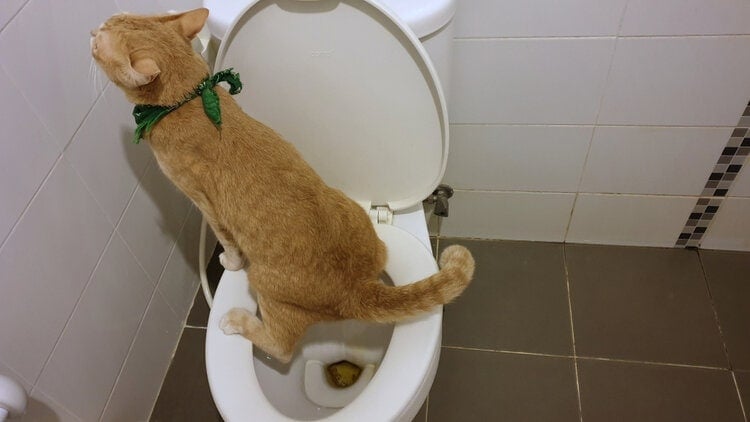Avoid Flush Cat Poop Down Your Toilet - Safeguard Your Pipes Infrastructure
Avoid Flush Cat Poop Down Your Toilet - Safeguard Your Pipes Infrastructure
Blog Article
Just about every person maintains their personal assumption involving How to Dispose of Cat Poop and Litter Without Plastic Bags.
:max_bytes(150000):strip_icc()/0S1A1090-49a8e2c66f8e41d6901f2559787a7f24.jpg)
Intro
As feline owners, it's important to bear in mind exactly how we dispose of our feline pals' waste. While it might appear convenient to flush cat poop down the toilet, this technique can have harmful consequences for both the atmosphere and human health and wellness.
Ecological Impact
Flushing feline poop presents harmful microorganisms and bloodsuckers into the water, positioning a substantial threat to marine ecosystems. These pollutants can adversely affect aquatic life and concession water quality.
Health and wellness Risks
Along with environmental concerns, purging pet cat waste can additionally position health and wellness dangers to human beings. Pet cat feces may have Toxoplasma gondii, a parasite that can create toxoplasmosis-- a possibly serious health problem, particularly for expectant women and individuals with weakened immune systems.
Alternatives to Flushing
Luckily, there are much safer and much more accountable means to deal with pet cat poop. Consider the adhering to alternatives:
1. Scoop and Dispose in Trash
The most common method of dealing with pet cat poop is to scoop it right into a biodegradable bag and throw it in the trash. Make sure to use a dedicated litter scoop and deal with the waste quickly.
2. Use Biodegradable Litter
Select eco-friendly feline litter made from products such as corn or wheat. These litters are environmentally friendly and can be safely thrown away in the garbage.
3. Bury in the Yard
If you have a yard, take into consideration burying cat waste in an assigned area away from veggie yards and water sources. Be sure to dig deep enough to stop contamination of groundwater.
4. Mount a Pet Waste Disposal System
Buy a pet waste disposal system specifically designed for cat waste. These systems make use of enzymes to break down the waste, decreasing odor and ecological impact.
Final thought
Responsible pet possession extends past giving food and sanctuary-- it likewise involves proper waste administration. By refraining from flushing cat poop down the toilet and going with alternative disposal methods, we can minimize our environmental impact and safeguard human health and wellness.
Why Can’t I Flush Cat Poop?
It Spreads a Parasite
Cats are frequently infected with a parasite called toxoplasma gondii. The parasite causes an infection called toxoplasmosis. It is usually harmless to cats. The parasite only uses cat poop as a host for its eggs. Otherwise, the cat’s immune system usually keeps the infection at low enough levels to maintain its own health. But it does not stop the develop of eggs. These eggs are tiny and surprisingly tough. They may survive for a year before they begin to grow. But that’s the problem.
Our wastewater system is not designed to deal with toxoplasmosis eggs. Instead, most eggs will flush from your toilet into sewers and wastewater management plants. After the sewage is treated for many other harmful things in it, it is typically released into local rivers, lakes, or oceans. Here, the toxoplasmosis eggs can find new hosts, including starfish, crabs, otters, and many other wildlife. For many, this is a significant risk to their health. Toxoplasmosis can also end up infecting water sources that are important for agriculture, which means our deer, pigs, and sheep can get infected too.
Is There Risk to Humans?
There can be a risk to human life from flushing cat poop down the toilet. If you do so, the parasites from your cat’s poop can end up in shellfish, game animals, or livestock. If this meat is then served raw or undercooked, the people who eat it can get sick.
In fact, according to the CDC, 40 million people in the United States are infected with toxoplasma gondii. They get it from exposure to infected seafood, or from some kind of cat poop contamination, like drinking from a stream that is contaminated or touching anything that has come into contact with cat poop. That includes just cleaning a cat litter box.
Most people who get infected with these parasites will not develop any symptoms. However, for pregnant women or for those with compromised immune systems, the parasite can cause severe health problems.
How to Handle Cat Poop
The best way to handle cat poop is actually to clean the box more often. The eggs that the parasite sheds will not become active until one to five days after the cat poops. That means that if you clean daily, you’re much less likely to come into direct contact with infectious eggs.
That said, always dispose of cat poop in the garbage and not down the toilet. Wash your hands before and after you clean the litter box, and bring the bag of poop right outside to your garbage bins.
https://trenchlesssolutionsusa.com/why-cant-i-flush-cat-poop/

I was shown that write-up about Don’t flush cat feces down the toilet through someone on a different site. In case you liked our blog post kindly don't forget to share it. I praise you for your time. Kindly check up our blog back soon.
Get A Free Quote Report this page